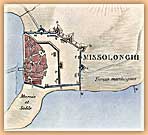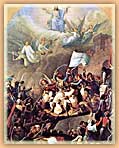 |

At the end of March 1825, that is when Ibrahim Pasha began his campaign in the Peloponnese, Mehmed Reshid Pasha (usually known as Kutahye)
conquered Makrynoros, the passage from Epirus to west-central Greece, and then headed to Missolonghi with apparent ease. The defenders of the town, the centre of the revolution in west-central Greece, had reinforced the defences from land and the shallow lagoon. Many chieftains from neighbouring regions hurried to Missolonghi as well. The siege began at the end of April 1825 and was carried out in two phases, lasting the whole of the year. Until October the besieged withstood the pressure successfully and temporarily obliged Kutahye to cancel the siege, but this was only to become more intolerable (November 1825). Finally, on the night of the 10/11 of April 1826, the defenders, worn out by the twelve-month siege and the lack of food, brought off a desperate and at the same time heroic end.
The digging of trenches and underground galleries (lagoumia) was a tactic used by both sides. The revolutionary Kostas Chormovas was in fact known as Lagoumitzis for his skill in making underground mines. The Greek navy had been called upon several times to raise the siege and to reinforce the besieged with troops, munitions and provisions. Some of its efforts were effective, others unsuccessful. At the end of July 1825 and in the middle of January 1826, Andreas Miaoulis managed to lift the naval blockade, thus giving hope to the besieged. However, the failure in February 1826 determined to a large extent the fall of Missolonghi. Finally, the attempt of the besieged to coordinate their action with Karaiskakis and other armed men who were at the rear of the Ottoman army and proceeded with small-scale operations was important for the whole operation. Usually they carried out noctural assaults against the enemy camp and against convoys.
Furthermore they conducted sorties from the bastions, aiming at conquering the closest positions of the Ottomans to Missolonghi. Such operations had forced Mehmed Reshid Pasha to withdraw the siege in autumn 1825. This meant that supplies could reach the besieged and the fortification be strengthened. But Kutahye was soon reinforced by the arrival of Ibrahim.
From February 1826 the situation for the besieged became harder and harder every day. The fact that the neighbouring town of Anatoliko (Aitoliko) had surrendered, that the Ottomans now controlled the shallow lagoon and that the attempt to lift the naval blockade was unsuccessful - all these
contributed to the weakening of morale. In many conflicts the soldiers fought hand to hand while the bombardment of the town was incessant. Thus, it was decided that the town should be deserted in a nocturnal sortie to be carried out on Palm Sunday of 1826. The plan was to make the sortie from three different points. Two of the three units were composed of combatants under Notis Botsaris and Dimitris Makris, while the third unit consisted of non-combatants and the small garrison. However, Ibrahim had learnt of the plan. The two combat units managed to cut lanes through the besieging forces by fighting and were pursued to the area of Zygos. Then they moved on first to Salona (Amfissa) and then to Nauplion where they were welcomed as heroes. The legend of the 'guard of Missolonghi' was established.
The third body, however, did not manage to escape. Panic broke out at the moment of the sortie, most of the unit returned to the town and were killed in the ensuing destruction. The fall of Missolonghi was followed by the capitulation of many chieftains from Rumeli. The Ottomans now controlled the whole of central Greece, west and east, apart form one point, the Acropolis,
the only fort controlled by revolutionaries; and this was the next target for Kutahye.
|


 |